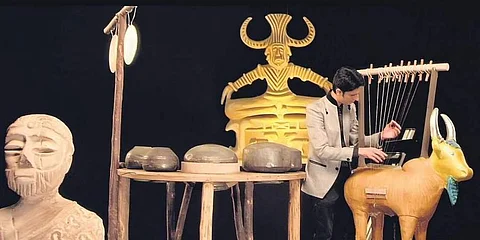

The year was 2011. Music director Shail Vyas was reading a story set in 400 BC, in which a musician performed for a king. The musician in Vyas became curious. He began to wonder whether the instrument mentioned in the story existed in that era, He turned to Google, but neither the search engine nor his sources in Mumbai University’s sound department had the answer. To crack the mystery, the qualified systems engineer trained in Hindustani and Western music started on a research project of his own. It would change the course of his life.
In the past 10 years, Vyas has written multiple papers, one of which will be published in the Indian Archaeological Society’s journal ‘Puratatva’ this October. “I am also excited about my book which will be out this year,” says the musicologist. This July, he gave a talk and a performance at Delhi’s India International Centre where he was in conversation with eminent archaeologists such as RS Bisht, Vasant Shinde and BR Mani.
When he began his research, Vyas’s career in Bollywood was just shaping up, but the background score for Amol Palekar’s Samaantar (2009) is his. He recorded songs with Japanese musicians for Aparna Sen’s The Japanese Wife (2010). But his passion for music and history urged him to learn more about Harappan musicology and linguistic evidence. Vyas spent years recreating ancient Indian musical instruments and unravelling Harappan culture’s musical heritage.
One of his major findings was that the Harappan civilisation most likely had complex musical systems, including lyres, harps, lutes and a variety of drums, flutes and clappers. These instruments were extant in every large and sophisticated urban civilisation. Vyas also discovered that many of Harappan musical instruments are played in various forms until today. Vyas found the Harappan influence in music and performance in Mesopotamia fascinating and came across sketches of lyres, harps, drums and clappers on seals, drawings and tablets from Mesopotamia. This meant that along with trade, many instruments were exported to West Asia from India in 3 BCE. Until now he has created early prototypes of 10 instruments from the Harappan period.
Getting the prestigious Homi Bhabha fellowship in 2018 helped. Vyas found that 30 of the 60 Sumerian terms related to music (such as names of musical instruments) were similar to those recorded in the Rig Veda. This was verified using archaeological, botanical, zoological and linguistic data. Vyas now wants to weave his insights into contemporary music. “I discovered that the Mangalturya was played at festivals, and Mrityuturya at funerals. Emotions were the same then and now. Biologically we’re not different human beings,” says the musician. In past-obsessed India, Vyas seems to have struck the right note.